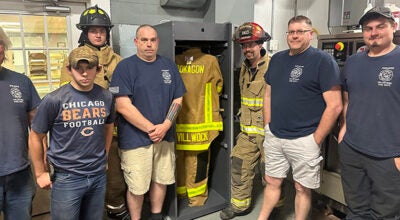Historian recounts story of local pilot interned by Swiss during World War II
Published 8:49 am Thursday, January 25, 2018
DOWAGIAC — Above the skies of Saarbrucken, Germany, on July 13, 1944, Berrien Center’s Clare Hubbard stood vigil beside his .50 caliber machinegun on the right waist of a B-24 Liberator bomber — a plane he and his crewmates affectionately referred to as “Our Honey.”
Hubbard and the rest of the flight team were only on their third bombing sortie, assigned to deliver their explosive payload over the railroad yards in the southwest German city. The gunner watched as the flak from enemy anti-aircraft exploded into black puffs around them as the pilot made its approach to the plane’s target, and anticipated the familiar upward lurch when the bombardier toggled the aircraft’s bombs.
Our Honey’s trip to Saarbrucken was fated to be only one-way, though, as — right above the crew’s target — the enemy was able to strike the aircraft, taking down two of its four engines. With no way to make it safely back to Allied terrorist, the B-24’s pilot decided to crash land in nearby Switzerland, which had refused to take sides during the conflict.
While Hubbard and his crewmates survived the German’s attack, their ordeals had only just begun, as they became internees in the neutral European nation.
Kathy Cyr, executive director of the Berrien County Historical Association, described the experiences the Berrien County man went through during his captivity in Switzerland, in a talk titled “Captive in the Alps: An Internee in Switzerland,” that she delivered to audiences at the Cass County Council on Aging Front Street Crossing Wednesday morning. Cyr was invited to both the Dowagiac and Cassopolis locations of the agency that day to speak.
Hubbard was one of around 1,500 American airmen who ended up crashing or landing in Switzerland during World War II. While the European country was aligned with neither side of the war, U.S. servicemen who wound up in its borders were kept in captivity inside the nation until after the conflict.
In spite of their captivity, the U.S. government denied most internees the status of prisoners of war. In fact, during the conflict, stories — fueled by German propaganda — began spreading that American airmen began intentionally flying into neutral nations like Switzerland or Sweden to get out of fighting.
“Their [internees] stories constitute an important, if little known, chapter in the history of that conflict,” Cyr said. “World War II internees have long suffered from public and governmental misconceptions of their wartime situations.”
Allied aircraft that flew into Swiss airspace were often quickly intercepted by fighters hailing from the country’s air force. Though protocol was for Swiss pilots to help lead foreign planes to a safe place to land, in some cases, they actually began firing upon them without warning, as happened in April 1944, when two Swiss planes shot down a damaged B-24 that was attempting to land, killing six of the 10 crewmen inside, Cyr said.
“Swiss authorities answered an official American protest with a bland statement that the bomber crew had ignored orders to land,” she said.
Not one American aircraft that landed in Switzerland during the war was fully intact, all suffering from damage from the enemy.
Hubbard, after spending a month recovering from a broken ankle he sustained after bailing out of his bomber, was placed them in an internment camp at Wengen, a ski-resort village where the Swiss government converted 14 luxury hotels into housing for internees.
Although the conditions were better than a solider would face being held by Axis forces, Americans were not treated entirely cordially by their Swiss captors. For example, the Swiss turned off heat inside the converted hotels during the winter, Cyr said.
Those who were caught attempting escape were often transferred to the Wauwilermoos punishment camp, where prisoners were treated worse than if they fell into Nazi hands, Cyr said.
Some 200 Americans were sentenced to stay at the camp, where they had to sleep on lice-infested straw on the floor, eat slop poured into the prison through pipes and had no access to medical care, mail or Red Cross parcels.
Fortunately, Hubbard was able to return home to his wife, Thelma, safely in March 1945, as the European front of the war came to a close. After living for many years in Berrien Center, they later moved to Boca Raton, Florida.
Hubbard died in 2002.







